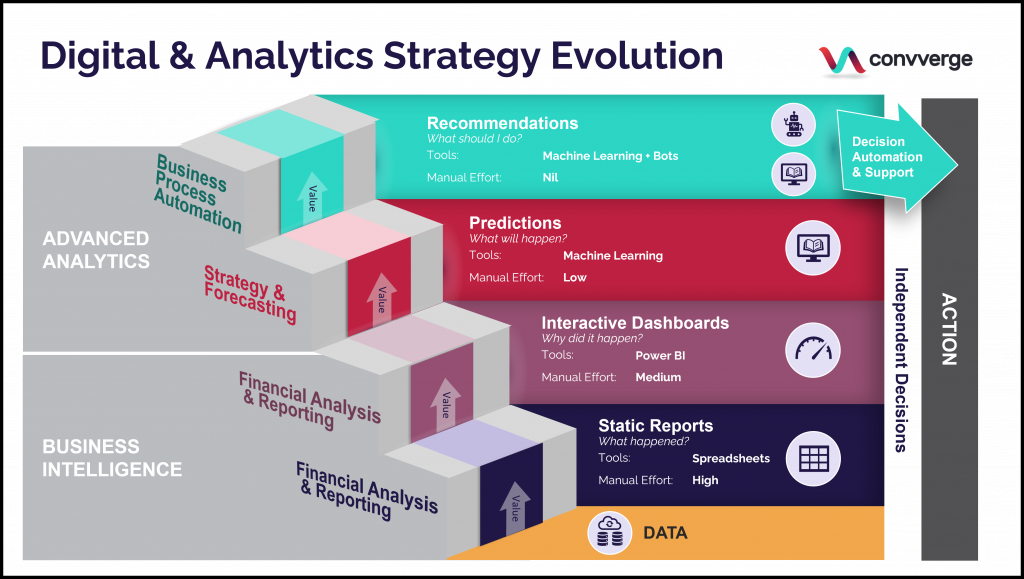Home / Blog / Insights / How to Evolve Your Data and Analytics Strategy?

•
How to Evolve Your Data and Analytics Strategy?
In a recent survey, Microsoft Canada explored whether business leaders are effectively using data. Of 658 decision-makers surveyed, 61% agreed that a key to business success is data and that includes understanding how to draw actionable insights from it. There is a challenge though, as the survey also found that only 34% of businesses are putting a comprehensive data strategy in place. (1) Why so? What’s holding so many companies back from employing a data and analytics strategy when they know it’s a key to success?
In some cases, we know that there is a lack of understanding of how a modern data and analytics strategy can evolve in business. So, let’s break it down a bit.
What is Data?
Simply put, data is the specific facts, statistics or items of information collected in your business. Business data is often numeric and can extend to include a set of values about people, objects, or transactions depending on what your business focus is.
What is Analytics?
Analytics is the computing process of analyzing data and reporting important patterns within your business. Analytics is about using technology to visually report and highlight actionable insights to decision-makers. With the right data structure and analysis tools, analytics insights can be served in real-time to help teams be more agile and make informed decisions that drive growth and innovation, improve the client experience, and most importantly stay competitive.
The Next Level of Thinking
It’s important to remember that data is an input, and it needs to be trusted, truthful and valid. When you can leverage data and analytics tools from a volume, velocity, and variety perspective you can begin to present information, make predictions, and innovate.
As Microsoft Canada’s President, Kevin Peesker, said “Data has become the most valuable currency for organizations in a digital, cloud-first world. Regardless of the size or type of organization, leveraging AI, data and analytics is crucial.” (1)
What is a Data and Analytics Strategy?
A data and analytics strategy is about how you organize, store, and structure your business data in a modern framework so that the raw data can be used to improve business intelligence and decision-making. When set up correctly, business insights can be delivered in real-time through custom reports and dashboards so that teams can see what’s going on in the business and use them to aid in making informed decisions.
Data and analytics strategy isn’t new to the business as reporting and analysis are important elements of all business success. What is new in this realm is the tools available and how data can be structured and modelled so it can be deciphered by analytics platforms, AI, and machine learning to highlight critical business information.
An important suggestion for leaders here is that your data and analytics strategy should also align to your company’s corporate strategy. With defined Key Performance Indicators (KPI) that map to a corporate strategic plan, you can drive the focus needed to align the correct ingestion of data into your organization.
How to Evolve your Data and Analytics Strategy?
Ground Floor – Data
There is no magic wand here, rather this is about building a plan and prioritizing data and analytics as a foundation. From here the strategy grows into your data framework. This framework extends to types of data inputs (i.e. apps/systems), storage solutions (i.e. data warehouse/data lake), and analysis and reporting (i.e. dashboards, predictive analysis). With these foundational pieces, you can start to evolve your business into higher levels of valuable business intelligence integrations, advanced analytics, and ultimately reach a point where there can be decision automation and support.
Level 1 – Descriptive Analytics + Static Reports
This is the starting level of data and analytics strategy and the one that most are familiar with. Spreadsheets are the tool of choice, and it requires a high people effort to track and input data as well as report on it. Turnaround times to deliver static reports range, but as you likely know report development is a significant time effort to prepare and validate before being published. From there the analysis of the reports is left to a few centralized people in the organization who are most familiar with the numbers to draw conclusions, make recommendations and/or decisions.
Level 2 – Diagnostic Analytics + Interactive Dashboards
The next level of business intelligence is about being more diagnostic with the data in a more dynamic and visual way. This level starts to decentralize the decision-making effort to a broader group of people as key roles in the company can access and decipher information coming through interactive dashboards and/or visual reports. With a proper data framework and analytics software at work, like Power BI, to compute and display the data as it is collected the greater the business intelligence offering is to the business and the faster the response to changes in the business.
Level 3 – Advanced Analytics – Predictions + Forecasting
At level 3, it’s possible for organizations to extend into more advanced analytics areas like predictive analytics to forecast trends, events, and consumer behaviours. By using an ever-growing list of technologies like machine learning, artificial intelligence and more. With these tools being used organizations can start to draw real insights, act smarter and faster, and with less effort.
Level 4 – Advanced Analytics – Recommendations + Automation
At the highest level, lies further advanced analytics options whereby data being processed and computed can be programmed to make recommendations and/or trigger automated actions in the business. A simple example of this level might be inventory management, whereby bots could be programmed to trigger a restock of an item automatically based on the data your system is deciphering from activities in the business. At Level 4, automation and decision support are doable, which frees up time for your people to focus on more valuable areas of their role.
In Summary
Data is pervasive, and actionable intelligence from data is elusive. When it comes to data and analytics strategy you want to be able to transform data to intelligent action and refresh business processes. To do this, you need to be able to easily analyze massive amounts of data. This ability to thoroughly analyze data is what will help take you from seeing (Level 1) “what happened” and understanding (Level 2) “why it happened” to predicting (Level 3) “what will happen” and ultimately, knowing (Level 4) “what should I do”. It is then that you can establish an intelligent enterprise aimed at value creation and risk management.
Convverge | A Business Intelligence Consulting Partner
Harnessing your data and analytics strategy is a game-changing area for businesses. It’s one area of our specialities focus that is becoming more and more popular and that is for good reason. Many companies struggle because they aren’t always sure where to start or don’t have the right skillset in-house. This is where the team at Convverge shines. As a Microsoft Gold Partner, our team of business analytics experts holds a gold-level certification in data analytics and knows tools like Power BI inside and out. By collaborating with our team, you can work to build out your data and analytics strategy. Our aim is to add horsepower to your team and help uncover what opportunities are possible in your business. Our team loves business intelligence consulting and helping you harness your data to realize its full potential. Contact us today and get going on your data and analytics strategy.
Additional Resources:



